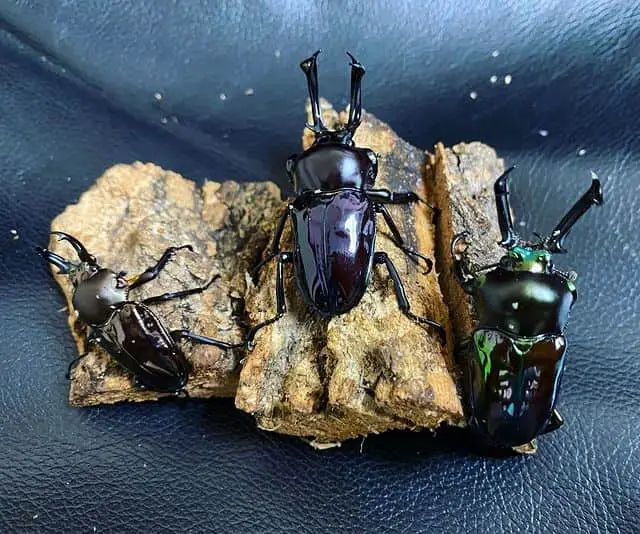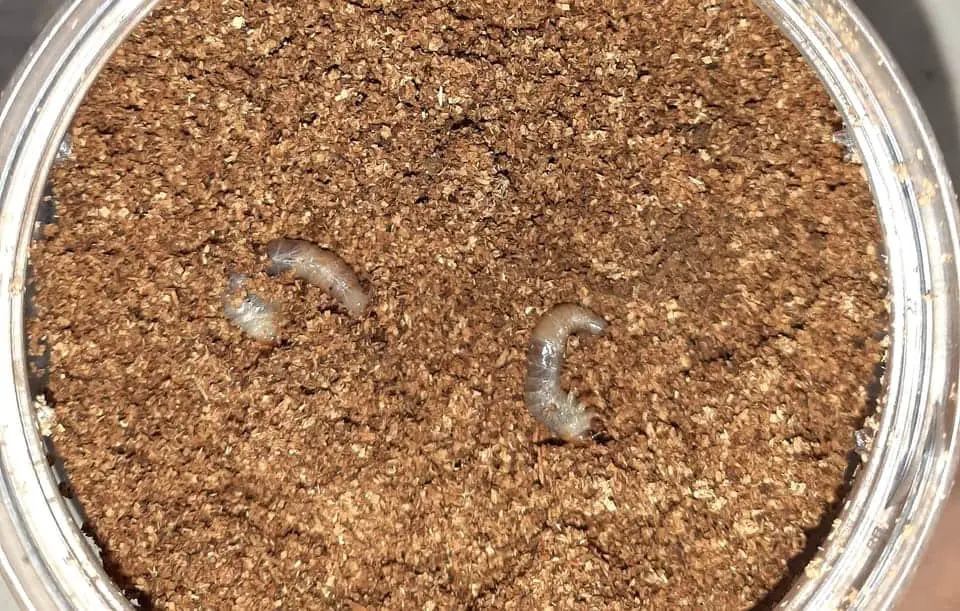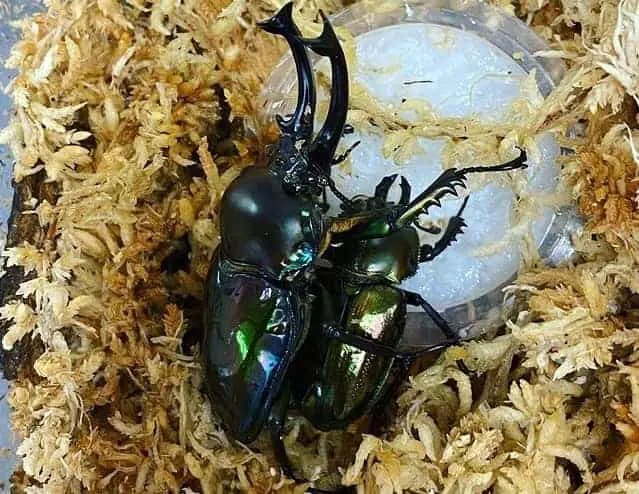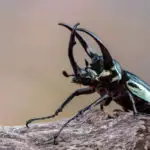Rainbow stag beetles are good pets for new beetle keepers because they have short development time despite having long lifespan compared with other large beetles. I’ve compiled my learning from keeping rainbow stag beetles in this guide and hope that it helps you.
Keep the rainbow stag beetle grubs in moist substrates. Replace spent substrates regularly for 6-12 months. Transfer the emerged adult into a ventilated tank with some substrates and barks. Feed it with beetle jelly. Move the gravid female into a tank with decay log buried in flake soil to lay eggs.
Keep reading to find out more details on caring of rainbow stag beetles at different stages
- Basic Introduction to the Rainbow Stag Beetles
- Getting Rainbow Stag Beetles
- How to Care for Rainbow Stag Beetle Grubs
- How to Sex Rainbow Stag Beetle Grubs
- Pupation Care
- Preparing Housing for Adult Rainbow Stag Beetles
- How to Feed Adult Rainbow Stag Beetles
- Recommended Supplies
- How to Breed Rainbow Stag Beetles
- Handling Rainbow Stag Beetles
Basic Introduction to the Rainbow Stag Beetles
Rainbow stag beetle is scientifically known as Phalacrognathus muelleri. It is native to forests in Queensland in Australia and New Guinea.
As implied by its name, the rainbow stag beetles have colorful iridescent exoskeleton. Major male beetles have 2 prominent mandibles, while the minor male beetles have way shorter mandibles. They use their mandibles to fight for resources and the right to mate.
Female beetles do not possess large mandibles, and have a prominent longitudal markings on her thorax.

A major rainbow stag beetle can grow up to 2.7” (~6.8 cm) in length including their mandibles. Female beetles, on the other hand, are smaller in size. These beetles are good fliers and they are active at night.
Rainbow stag beetles are known to be hardy. It can tolerate temperatures as high as 86 °F (30 °C) and as low as 50 °F (10 °C).
In captivity, well-taken care rainbow stag beetle adults can live for 12-18 months.
Getting Rainbow Stag Beetles
Given that rainbow stag beetles are found only in Australia and New Guinea, it can be very difficult to get them unless beetle keeping is popular in where you stay. Importing, keeping and/or breeding of rainbow stag beetles may require permit from your local authority.
Unless you are staying in Japan or Taiwan, most likely you can get rainbow stag beetles only from online stores. It is more fun and satisfying to get some grubs and grow them into adults.
However, if you have no time but have enough budget, you can buy the adult beetles. The risk of buying an adult beetle is that you don’t really know how old the beetle is. Look for sign of injury or lost limbs if you are buying from a physical store.
How to Care for Rainbow Stag Beetle Grubs

Keep the grubs in moist flake soil or kinshi at 72-79 °F. Change the substrate after it is consumed. It takes 6-12 months for the grubs to turn into adults.
Rainbow stag beetle grubs can be kept together in the same container. However, I kept them singly in separate containers to maximize growth.
A newly hatched grub can be placed in a 1 pt (~500 mL) container with flake soil. The depth of flake soil should be at least 5 times the thickness of grub. You can either buy flake soil or make your own flake soil following my recipe here. You can also use kinshi instead of flake soil if you want to grow bigger stag beetles.
Keep the substrate moist but not wet. The adequately moist substrates should hold together in a shape when squeezed with both hands, but there should not be dripping water. Excessive moisture will kill the eggs!
Make a few ventilation holes on the container. Place the housing in the dark. Maintain the temperature between 72-79 °F (22-26 °C).
The grub will feed its way to the first molt in about 30 days, and the second molt in another 6-8 weeks. Move the grub into a 2 qt (~2 L) container with new flake soils 1 month after the 2nd molt. Female grubs can be housed in a 1 qt (~1 L) container instead.
Change the flake soil every 3-4 months. It is quite difficult to ascertain the feeding rate of your grubs because the grubs often smear their feces. The smeared feces release bacteria, which help the grubs to digest some substrates before the grubs feed on them.
When changing the substrates, always retain 10% of the substrates and place the grub onto the old substrates. This helps to retain some of the beneficial bacteria.
If you have the budget and are able to keep the beetle consistently around 72-77 °F (~22-25 °C), consider using Kinshi instead of flake soil if Kinshi is available.
Kinshi is basically sawdust broken down by mushrooms. The likelihood of getting a major male is higher if you use Kinshi compared to using flake soil.
Due to budget concern, I use Kinshi only for male beetles after the second molt. There is a challenge though. The beetle may refuse to feed on Kinshi if it was transferred from flake soil. To overcome this, dig a hole out of the kinshi, put in some old flake soil in the hole and place the grub on the flake soil.
Kinshi should be changed once 70% of it turns brown.
How to Sex Rainbow Stag Beetle Grubs
How do you know which grub is male and which is female? To sex the grubs, look at the dorsal part of their abdomen. You can see a visible white or yellow color spot through the abdomen of a female stag beetle grub. This spot is said to be the ovary of the beetle when it turns into an adult.
Another method is by comparing the size of their head capsules. Male has a larger head capsule than a female grub. However, this is a relative comparison, which is very subjective.
Pupation Care
When it is time to pupate, the grub will move to the bottom of the container to build a pupation chamber, within which it pupates. Do not disturb the grubs once it starts building the pupation chamber. Refer to the guide here if you accidentally break the pupation chamber.
It takes about 4 weeks for the adult beetles to emerge from pupae. The adult beetle will remain dormant in the pupation chamber for another 4 weeks before coming out from the pupation chamber. The beetle does not need food during this period. Learn more about taking care of dormant beetles here.
Preparing Housing for Adult Rainbow Stag Beetles
The dimension of your housing for the atlas beetle should be at least 3 times the length of your beetle in length, 2 times in width and 2 times in height. For each additional beetle, increase another 50% to the length and width of the housing.
You can use peat/soil mixture in 1:1 ratio as the substrates for the housing. The depth of substrate should be 2 times the thickness of the beetle so that the beetles can burrow. Keep the substrates moist (but not wet) through misting using a bottle sprayer from time to time.
Rainbow stag beetles can be kept together in the same container. However, to prevent exhaustion from repeated mating, separate the male and female beetles after they mate.
Make sure the housing is covered with a lid to prevent the beetles from flying out. You should also put some tree branches or tree bark for the beetles to climb. The housing should be ventilated and placed away from direct sunlight.
How to Feed Adult Rainbow Stag Beetles
Feed the rainbow stag beetle with cut fruits such as a slice of banana, orange, apples, or pineapple a quarter of their body size. Place the fruit onto a sauce plate so that you can clean it easily. Remove any unconsumed fruit everyday to prevent growth of molds.
You should consider feeding your beetles with beetle jelly. It is more convenient to use in terms of preparation and storage. Moreover, the jelly doesn’t grow mold as easily unlike the fruits. Some beetle jellies even boast various fitness benefits such as improved longevity, stronger beetles, and larger offspring. Here is the recipe of my beetle jelly that you can try out.
Always replenish the food when it runs out. Beetles get enough water from the fruits and jelly. Hence, additional water supply is not necessary.
Recommended Supplies
Here’s my recommended supplies that you can consider getting for your rainbow stag beetles (I may earn some commission if you buy from the link):
Remember to check out our recommended books to learn more about keeping rainbow stag beetle.
How to Breed Rainbow Stag Beetles
Keep the male and female beetles in the same tank for mating. Move the gravid female to a nursery tank filled with flake soil and buried decay log. Feed her with beetle jelly.

Female beetles generally grow faster than male beetles, and may get too old to breed when the male beetles emerge. If you plan to breed rainbow stag beetles, you can keep the 3rd instar female grub at 72 °F (22 °C) to delay its growth and keep the male grub at 79 °F (26 °C) to accelerate its growth rate.
You can let the beetles mate 1 month after they start feeding. To do that, simply place the male beetle onto the female beetle.
If either or both beetles are reluctant to mate after 10-20 minutes, separate them and try again after another few days. Alternatively, you can leave the beetles in the same container for up to a week.
After the mating is successful, remove the female beetle and place her into a nursery chamber.
The length of the nursery chamber for rainbow stag beetles should be at least 6 times the length of the female beetle and 4 times for width and height. Fill the container with flake soil up till 4” (~10 cm) in depth. The flake soil should be moist (but not wet) and compressed.
Place a few pieces of soft decay woods (can be bought from beetle hobby stores) on the compressed flake soil. Bury ⅔ of the decay woods with pre-baked, moist sawdust. Cover and ventilate the chamber.
Continue to feed the gravid beetle when she is in the nursery chamber.
The rainbow stag beetles will chew through the soft decayed wood and lay eggs in it. Some of them will lay eggs in the flake soil as well. Remove the gravid beetle 1 month after you placed her in the nursery chamber
You can start to collect the grubs 2 months after first seeing the female burrows into the flake soil. Most of the eggs would have hatched, and the grubs are now between 1st to 2nd instars.
Handling Rainbow Stag Beetles
While you can put the grubs onto your hand if you want, be careful not to drop them. They will be severely injured and may die if you drop them!
Try not to disturb them too much, especially when the late 3rd instar grub is building its pupation chamber.
While the adult beetles are protected with a thick layer of armor, you want to be gentle when handling them. You should be able to hold them easily. Always grab their thorax instead of their legs. Their legs are fragile and have spines that might hurt you!
Never forcefully pull the beetles from a surface they grasp because that may break their legs.
Despite having large mandibles, bite of rainbow stag beetle is not painful.



